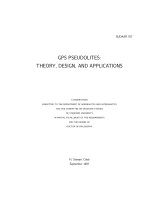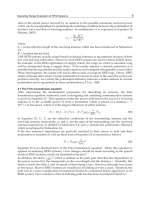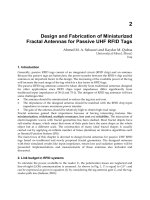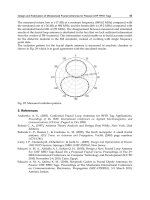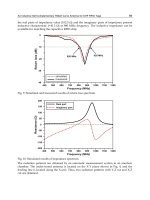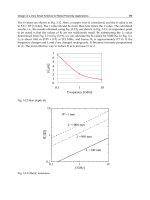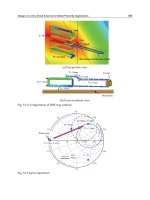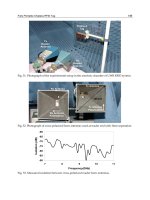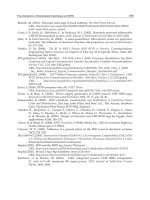Algorithm design and applications
Bạn đang xem bản rút gọn của tài liệu. Xem và tải ngay bản đầy đủ của tài liệu tại đây (12.67 MB, 803 trang )
www.it-ebooks.info
www.it-ebooks.info
Algorithm Design and
Applications
Michael T. Goodrich
Department of Information and Computer Science
University of California, Irvine
Roberto Tamassia
Department of Computer Science
Brown University
www.it-ebooks.info
www.it-ebooks.info
iii
www.it-ebooks.info
To Karen, Paul, Anna, and Jack
– Michael T. Goodrich
To Isabel
– Roberto Tamassia
www.it-ebooks.info
Contents
Preface
xi
1 Algorithm Analysis
1.1
1.2
1.3
1.4
1.5
1
Analyzing Algorithms . . . . . . . . .
A Quick Mathematical Review . . . .
A Case Study in Algorithm Analysis
Amortization . . . . . . . . . . . . .
Exercises . . . . . . . . . . . . . . .
Part I:
.
.
.
.
.
.
.
.
.
.
.
.
.
.
.
.
.
.
.
.
.
.
.
.
.
.
.
.
.
.
.
.
.
.
.
.
.
.
.
.
.
.
.
.
.
.
.
.
.
.
.
.
.
.
.
.
.
.
.
.
.
.
.
.
.
.
.
.
.
.
Data Structures
2 Basic Data Structures
2.1
2.2
2.3
2.4
51
Stacks and Queues
Lists . . . . . . . . .
Trees . . . . . . . .
Exercises . . . . . .
.
.
.
.
.
.
.
.
.
.
.
.
.
.
.
.
.
.
.
.
.
.
.
.
.
.
.
.
.
.
.
.
.
.
.
.
.
.
.
.
.
.
.
.
.
.
.
.
.
.
.
.
.
.
.
.
.
.
.
.
.
.
.
.
.
.
.
.
.
.
.
.
.
.
.
.
.
.
.
.
.
.
.
.
.
.
.
.
.
.
.
.
Searches and Updates . . . . . . . .
Range Queries . . . . . . . . . . . .
Index-Based Searching . . . . . . .
Randomly Constructed Search Trees
Exercises . . . . . . . . . . . . . . .
.
.
.
.
.
.
.
.
.
.
.
.
.
.
.
.
.
.
.
.
.
.
.
.
.
.
.
.
.
.
.
.
.
.
.
.
.
.
.
.
.
.
.
.
.
.
.
.
.
.
.
.
.
.
.
.
.
.
.
.
.
.
.
.
.
.
.
.
.
.
3 Binary Search Trees
3.1
3.2
3.3
3.4
3.5
Ranks and Rotations
AVL Trees . . . . . .
Red-Black Trees . .
Weak AVL Trees . .
Splay Trees . . . . .
Exercises . . . . . .
.
.
.
.
.
.
.
.
.
.
.
.
.
.
.
.
.
.
.
.
.
.
.
.
.
.
.
.
.
.
.
.
.
.
.
.
.
.
.
.
.
.
.
.
.
.
.
.
.
.
.
.
.
.
.
.
.
.
.
.
.
.
.
.
.
.
.
.
.
.
.
.
.
.
.
.
.
.
.
.
.
.
.
.
.
.
.
.
.
.
.
.
.
.
.
.
Priority Queues . . . . . . . . . . . . . . . .
PQ-Sort, Selection-Sort, and Insertion-Sort
Heaps . . . . . . . . . . . . . . . . . . . . .
Heap-Sort . . . . . . . . . . . . . . . . . . .
Extending Priority Queues . . . . . . . . . .
Exercises . . . . . . . . . . . . . . . . . . .
.
.
.
.
.
.
.
.
.
.
.
.
.
.
.
.
.
.
.
.
.
.
.
.
.
.
.
.
.
.
.
.
.
.
.
.
.
.
.
.
.
.
.
.
.
.
.
.
.
.
.
.
.
.
.
.
.
.
.
.
v
www.it-ebooks.info
91
101
104
107
110
115
.
.
.
.
.
.
.
.
.
.
.
.
.
.
.
.
.
.
.
.
.
.
.
.
.
.
.
.
.
.
.
.
.
.
.
.
.
.
.
.
.
.
5 Priority Queues and Heaps
5.1
5.2
5.3
5.4
5.5
5.6
53
60
68
84
89
4 Balanced Binary Search Trees
4.1
4.2
4.3
4.4
4.5
4.6
3
19
29
34
42
117
120
126
130
139
149
155
157
158
163
174
179
182
Contents
vi
6 Hash Tables
6.1
6.2
6.3
6.4
6.5
6.6
187
Maps . . . . . . . . . . . . . . . .
Hash Functions . . . . . . . . . . .
Handling Collisions and Rehashing
Cuckoo Hashing . . . . . . . . . .
Universal Hashing . . . . . . . . .
Exercises . . . . . . . . . . . . . .
.
.
.
.
.
.
.
.
.
.
.
.
.
.
.
.
.
.
.
.
.
.
.
.
.
.
.
.
.
.
.
.
.
.
.
.
.
.
.
.
.
.
.
.
.
.
.
.
.
.
.
.
.
.
.
.
.
.
.
.
.
.
.
.
.
.
.
.
.
.
.
.
.
.
.
.
.
.
.
.
.
.
.
.
.
.
.
.
.
.
.
.
.
.
.
.
.
.
.
.
.
.
.
.
.
.
.
.
.
.
.
.
.
.
.
.
.
.
.
.
.
.
.
.
.
.
.
.
.
.
.
.
.
.
.
.
.
.
.
.
.
.
.
.
.
.
.
.
.
.
7 Union-Find Structures
7.1
7.2
7.3
7.4
219
Union-Find and Its Applications
A List-Based Implementation .
A Tree-Based Implementation .
Exercises . . . . . . . . . . . .
Part II:
.
.
.
.
.
.
.
.
241
Merge-Sort . . . . . . . . . . . . . . . . . . . .
Quick-Sort . . . . . . . . . . . . . . . . . . . . .
A Lower Bound on Comparison-Based Sorting
Exercises . . . . . . . . . . . . . . . . . . . . .
.
.
.
.
.
.
.
.
.
.
.
.
.
.
.
.
.
.
.
.
.
.
.
.
.
.
.
.
.
.
.
.
.
.
.
.
.
.
.
.
.
.
.
.
.
.
.
.
.
.
.
.
.
.
.
.
.
.
.
.
.
.
.
.
9 Fast Sorting and Selection
9.1
9.2
9.3
9.4
Bucket-Sort and Radix-Sort
Selection . . . . . . . . . .
Weighted Medians . . . . .
Exercises . . . . . . . . . .
Part III:
.
.
.
.
.
.
.
.
.
.
.
.
.
.
.
.
.
.
.
.
.
.
.
.
.
.
.
.
.
.
.
.
.
.
.
.
.
.
.
.
267
270
276
279
Fundamental Techniques
283
The Fractional Knapsack Problem . . .
Task Scheduling . . . . . . . . . . . . .
Text Compression and Huffman Coding
Exercises . . . . . . . . . . . . . . . . .
.
.
.
.
.
.
.
.
.
.
.
.
.
.
.
.
.
.
.
.
.
.
.
.
.
.
.
.
.
.
.
.
.
.
.
.
.
.
.
.
.
.
.
.
.
.
.
.
.
.
.
.
.
.
.
.
.
.
.
.
.
.
.
.
.
.
.
.
.
.
.
.
.
.
.
.
.
.
.
.
.
.
.
.
.
.
.
.
.
.
.
.
.
.
.
.
.
.
.
.
.
.
.
.
.
.
.
.
11 Divide-and-Conquer
11.1
11.2
11.3
11.4
11.5
243
250
257
259
265
.
.
.
.
10 The Greedy Method
10.1
10.2
10.3
10.4
221
225
228
236
Sorting and Selection
8 Merge-Sort and Quick-Sort
8.1
8.2
8.3
8.4
189
192
198
206
212
215
Recurrences and the Master Theorem
Integer Multiplication . . . . . . . . . .
Matrix Multiplication . . . . . . . . . .
The Maxima-Set Problem . . . . . . .
Exercises . . . . . . . . . . . . . . . .
www.it-ebooks.info
286
289
292
298
303
.
.
.
.
.
305
313
315
317
319
Contents
vii
12 Dynamic Programming
12.1
12.2
12.3
12.4
12.5
12.6
12.7
323
Matrix Chain-Products . . . . . . . . . . . . .
The General Technique . . . . . . . . . . . .
Telescope Scheduling . . . . . . . . . . . . .
Game Strategies . . . . . . . . . . . . . . . .
The Longest Common Subsequence Problem
The 0-1 Knapsack Problem . . . . . . . . . .
Exercises . . . . . . . . . . . . . . . . . . . .
.
.
.
.
.
.
.
.
.
.
.
.
.
.
.
.
.
.
.
.
.
.
.
.
.
.
.
.
.
.
.
.
.
.
.
.
.
.
.
.
.
.
.
.
.
.
.
.
.
.
.
.
.
.
.
.
.
.
.
.
.
.
.
13 Graphs and Traversals
13.1
13.2
13.3
13.4
13.5
13.6
353
Graph Terminology and Representations .
Depth-First Search . . . . . . . . . . . . .
Breadth-First Search . . . . . . . . . . . .
Directed Graphs . . . . . . . . . . . . . .
Biconnected Components . . . . . . . . .
Exercises . . . . . . . . . . . . . . . . . .
Part IV:
.
.
.
.
.
.
.
.
.
.
.
.
.
.
.
.
.
.
.
.
.
.
.
.
.
.
.
.
.
.
.
.
.
.
.
.
.
.
.
.
.
.
.
.
.
.
.
.
.
.
.
.
.
.
.
.
.
.
.
.
.
.
.
.
.
.
397
Single-Source Shortest Paths . . . . . . .
Dijkstra’s Algorithm . . . . . . . . . . . . .
The Bellman-Ford Algorithm . . . . . . . .
Shortest Paths in Directed Acyclic Graphs
All-Pairs Shortest Paths . . . . . . . . . .
Exercises . . . . . . . . . . . . . . . . . .
.
.
.
.
.
.
.
.
.
.
.
.
.
.
.
.
.
.
.
.
.
.
.
.
.
.
.
.
.
.
.
.
.
.
.
.
.
.
.
.
.
.
.
.
.
.
.
.
.
.
.
.
.
.
.
.
.
.
.
.
.
.
.
.
.
.
.
.
.
.
.
.
.
.
.
.
.
.
.
.
.
.
.
.
.
.
.
.
.
.
.
.
.
.
.
.
.
.
.
.
.
.
.
.
.
.
.
.
.
.
.
.
.
.
.
.
.
.
.
.
.
15 Minimum Spanning Trees
15.1
15.2
15.3
15.4
15.5
Flows and Cuts . . . . . . . .
Maximum Flow Algorithms . .
Maximum Bipartite Matching
Baseball Elimination . . . . .
Minimum-Cost Flow . . . . .
Exercises . . . . . . . . . . .
www.it-ebooks.info
399
400
407
410
412
418
423
Properties of Minimum Spanning Trees
Kruskal’s Algorithm . . . . . . . . . . . .
The Prim-Jarn´ık Algorithm . . . . . . . .
˚
Baruvka’s
Algorithm . . . . . . . . . . .
Exercises . . . . . . . . . . . . . . . . .
.
.
.
.
.
16 Network Flow and Matching
16.1
16.2
16.3
16.4
16.5
16.6
355
365
370
373
386
392
Graph Algorithms
14 Shortest Paths
14.1
14.2
14.3
14.4
14.5
14.6
325
329
331
334
339
343
346
425
428
433
436
439
443
.
.
.
.
.
.
.
.
.
.
.
.
.
.
.
.
.
.
.
.
.
.
.
.
.
.
.
.
.
.
.
.
.
.
.
.
.
.
.
.
.
.
.
.
.
.
.
.
.
.
.
.
.
.
.
.
.
.
.
.
.
.
.
.
.
.
.
.
.
.
.
.
.
.
.
.
.
.
.
.
.
.
.
.
.
.
.
.
.
.
.
.
.
.
.
.
.
.
.
.
.
.
.
.
.
.
.
.
445
452
458
460
462
469
Contents
viii
Part V:
Computational Intractability
17 NP-Completeness
17.1
17.2
17.3
17.4
17.5
17.6
17.7
473
P and NP . . . . . . . . . . . . . . . . .
NP-Completeness . . . . . . . . . . . .
CNF-SAT and 3SAT . . . . . . . . . . . .
VERTEX-COVER, CLIQUE, and SET-COVER
SUBSET-SUM and KNAPSACK . . . . . . .
HAMILTONIAN-CYCLE and TSP . . . . . .
Exercises . . . . . . . . . . . . . . . . .
.
.
.
.
.
.
.
.
.
.
.
.
.
.
.
.
.
.
.
.
.
.
.
.
.
.
.
.
.
.
.
.
.
.
.
.
.
.
.
.
.
.
.
.
.
.
.
.
.
.
.
.
.
.
.
.
.
.
.
.
.
.
.
.
.
.
.
.
.
.
.
.
.
.
.
.
.
.
.
.
.
.
.
.
The Metric Traveling Salesperson Problem
Approximations for Covering Problems . . .
Polynomial-Time Approximation Schemes .
Backtracking and Branch-and-Bound . . . .
Exercises . . . . . . . . . . . . . . . . . . .
.
.
.
.
.
.
.
.
.
.
.
.
.
.
.
.
.
.
.
.
.
.
.
.
.
.
.
.
.
.
.
.
.
.
.
.
.
.
.
.
.
.
.
.
.
.
.
.
.
.
18 Approximation Algorithms
18.1
18.2
18.3
18.4
18.5
Part VI:
507
529
Generating Random Permutations . . . .
Stable Marriages and Coupon Collecting .
Minimum Cuts . . . . . . . . . . . . . . .
Finding Prime Numbers . . . . . . . . . .
Chernoff Bounds . . . . . . . . . . . . . .
Skip Lists . . . . . . . . . . . . . . . . . .
Exercises . . . . . . . . . . . . . . . . . .
.
.
.
.
.
.
.
.
.
.
.
.
.
.
.
.
.
.
.
.
.
.
.
.
.
.
.
.
.
.
.
.
.
.
.
.
.
.
.
.
.
.
.
.
.
.
.
.
.
.
.
.
.
.
.
.
.
.
.
.
.
.
.
.
.
.
.
.
.
.
.
.
.
.
.
.
.
.
.
.
.
.
.
.
.
.
.
.
.
.
.
.
.
.
.
.
.
.
.
.
.
.
.
.
.
.
.
.
.
.
.
.
.
.
.
.
.
.
.
.
.
.
.
.
.
.
.
.
.
.
.
.
20 B-Trees and External Memory
20.1
20.2
20.3
20.4
20.5
External Memory . . . . . .
(2,4) Trees and B-Trees . .
External-Memory Sorting .
Online Caching Algorithms
Exercises . . . . . . . . . .
.
.
.
.
.
Range Trees . . . . . . .
Priority Search Trees . . .
Quadtrees and k-d Trees
Exercises . . . . . . . . .
.
.
.
.
531
534
539
546
551
557
563
569
.
.
.
.
.
.
.
.
.
.
.
.
.
.
.
.
.
.
.
.
.
.
.
.
.
.
.
.
.
.
.
.
.
.
.
21 Multidimensional Searching
21.1
21.2
21.3
21.4
511
515
518
521
525
Additional Topics
19 Randomized Algorithms
19.1
19.2
19.3
19.4
19.5
19.6
19.7
476
483
489
492
496
499
502
571
574
590
593
600
603
.
.
.
.
.
.
.
.
www.it-ebooks.info
.
.
.
.
.
.
.
.
.
.
.
.
.
.
.
.
.
.
.
.
.
.
.
.
.
.
.
.
.
.
.
.
.
.
.
.
.
.
.
.
.
.
.
.
.
.
.
.
.
.
.
.
.
.
.
.
.
.
.
.
.
.
.
.
.
.
.
.
605
609
614
618
Contents
ix
22 Computational Geometry
22.1
22.2
22.3
22.4
22.5
623
Operations on Geometric Objects .
Convex Hulls . . . . . . . . . . . .
Segment Intersection . . . . . . .
Finding a Closest Pair of Points . .
Exercises . . . . . . . . . . . . . .
.
.
.
.
.
.
.
.
.
.
.
.
.
.
.
.
.
.
.
.
.
.
.
.
.
.
.
.
.
.
.
.
.
.
.
.
.
.
.
.
.
.
.
.
.
.
.
.
.
.
.
.
.
.
.
.
.
.
.
.
.
.
.
.
.
.
.
.
.
.
.
.
.
.
.
23 String Algorithms
23.1
23.2
23.3
23.4
23.5
23.6
String Operations . . . . . . . . .
The Boyer-Moore Algorithm . . .
The Knuth-Morris-Pratt Algorithm
Hash-Based Lexicon Matching .
Tries . . . . . . . . . . . . . . . .
Exercises . . . . . . . . . . . . .
651
.
.
.
.
.
.
.
.
.
.
.
.
.
.
.
.
.
.
.
.
.
.
.
.
.
.
.
.
.
.
.
.
.
.
.
.
.
.
.
.
.
.
.
.
.
.
.
.
.
.
.
.
.
.
.
.
.
.
.
.
.
.
.
.
.
.
.
.
.
.
.
.
.
.
.
.
.
.
.
.
.
.
.
.
.
.
.
.
.
.
.
.
.
.
.
.
Greatest Common Divisors (GCD)
Modular Arithmetic . . . . . . . . .
Cryptographic Operations . . . . .
The RSA Cryptosystem . . . . . .
The El Gamal Cryptosystem . . . .
Exercises . . . . . . . . . . . . . .
.
.
.
.
.
.
.
.
.
.
.
.
.
.
.
.
.
.
.
.
.
.
.
.
.
.
.
.
.
.
.
.
.
.
.
.
.
.
.
.
.
.
.
.
.
.
.
.
.
.
.
.
.
.
.
.
.
.
.
.
.
.
.
.
.
.
.
.
.
.
.
.
.
.
.
.
.
.
.
.
.
.
.
.
.
.
.
.
.
.
24 Cryptography
24.1
24.2
24.3
24.4
24.5
24.6
Convolution . . . . . . . . . . . . . . .
Primitive Roots of Unity . . . . . . . .
The Discrete Fourier Transform . . . .
The Fast Fourier Transform Algorithm
Exercises . . . . . . . . . . . . . . . .
Formulating the Problem . . . . . . .
The Simplex Method . . . . . . . . .
Duality . . . . . . . . . . . . . . . . .
Applications of Linear Programming
Exercises . . . . . . . . . . . . . . .
A Useful Mathematical Facts
Bibliography
Index
www.it-ebooks.info
687
691
699
703
706
708
711
.
.
.
.
.
.
.
.
.
.
.
.
.
.
.
.
.
.
.
.
.
.
.
.
.
.
.
.
.
.
.
.
.
.
.
.
.
.
.
.
.
.
.
.
.
.
.
.
.
.
.
.
.
.
.
.
.
.
.
.
.
.
.
.
.
.
.
.
.
.
.
.
.
.
.
.
.
.
.
.
.
.
.
.
.
.
.
.
.
.
.
.
.
.
.
.
.
.
.
.
.
.
.
.
.
.
.
.
.
.
.
.
.
.
.
.
.
.
.
.
.
.
.
.
.
.
.
.
.
.
26 Linear Programming
26.1
26.2
26.3
26.4
26.5
653
656
660
664
669
680
685
25 The Fast Fourier Transform
25.1
25.2
25.3
25.4
25.5
625
630
638
642
646
713
715
717
721
727
731
.
.
.
.
.
734
739
746
750
753
761
765
774
www.it-ebooks.info
Preface
This book is designed to provide a comprehensive introduction to the design and
analysis of computer algorithms and data structures. We have made each chapter to
be relatively independent of other chapters so as to provide instructors and readers
greater flexibility with respect to which chapters to explore. Moreover, the extensive collection of topics we include provides coverage of both classic and emerging
algorithmic methods, including the following:
• Mathematics for asymptotic analysis, including amortization and randomization
• General algorithm design techniques, including the greedy method, divideand-conquer, and dynamic programming
• Data structures, including lists, trees, heaps, search trees, B-trees, hash tables, skip lists, union-find structures, and multidimensional trees
• Algorithmic frameworks, including NP-completeness, approximation algorithms, and external-memory algorithms
• Fundamental algorithms, including sorting, graph algorithms, computational
geometry, numerical algorithms, cryptography, Fast Fourier Transform (FFT),
and linear programming.
Application-Motivated Approach
This is an exciting time for computer science. Computers have moved beyond their
early uses as computational engines to now be used as information processors,
with applications to every other discipline. Moreover, the expansion of the Internet has brought about new paradigms and modalities for computer applications to
society and commerce. For instance, computers can be used to store and retrieve
large amounts of data, and they are used in many other application areas, such as
sports, video games, biology, medicine, social networking, engineering, and science. Thus, we feel that algorithms should be taught to emphasize not only their
mathematical analysis but also their practical applications.
To fulfill this need, we have written each chapter to begin with a brief discussion of an application that motivates the topic of that chapter. In some cases, this
application comes from a real-world use of the topic discussed in the chapter, and in
other cases it is a contrived application that highlights how the topic of the chapter
could be used in practice. Our intent in providing this motivation is to give readers
a conceptual context and practical justification to accompany their reading of each
chapter. In addition to this application-based motivation we include also detailed
pseudocode descriptions and complete mathematical analysis. Indeed, we feel that
mathematical rigor should not simply be for its own sake, but also for its pragmatic
implications.
xi
www.it-ebooks.info
Preface
xii
For the Instructor
This book is structured to allow an instructor a great deal of freedom in how to organize and present material. The dependence between chapters is relatively minimal,
which allows the instructor to cover topics in her preferred sequence. Moreover,
each chapter is designed so that it can be covered in 1–3 lectures, depending on the
depth of coverage.
Example Courses
This book has several possible uses as a textbook. It can be used, for instance,
for a core Algorithms course, which is classically known as CS7. Alternatively,
it could be used for an upper-division/graduate data structures course, an upperdivision/graduate algorithms course, or a two-course sequence on these topics. To
highlight these alternatives, we give an example syllabus for each of these possible
courses below.
Example syllabus for a core Algorithms (CS7) course:
1. Algorithm Analysis
(Skip, skim, or review Chapters 2–4 on fundamental data structures)1
5. Priority Queues and Heaps
6. Hash Tables
7. Union-Find Structures
8. Merge-Sort and Quick-Sort
9. Fast Sorting and Selection (if time permits)
10. The Greedy Method
11. Divide-and-Conquer
12. Dynamic Programming
13. Graphs and Traversals
14. Shortest Paths
15. Minimum Spanning Trees
16. Network Flow and Matching (if time permits)
17. NP-Completeness
18. Approximation Algorithms
Optional choices from Chapters 19–26, as time permits
The optional choices from Chapters 19–26 that could be covered at the end of the
course include randomized algorithms, computational geometry, string algorithms,
cryptography, Fast Fourier Transform (FFT), and linear programming.
1
These topics, and possibly even the topics of Chapters 5 and 6, are typically covered to at least a
basic level in a Data Structures course that could be a prerequisite to this course.
www.it-ebooks.info
Preface
xiii
Example syllabus for an upper-division/graduate Data Structures course:
1. Algorithm Analysis
2. Basic Data Structures
3. Binary Search Trees
4. Balanced Binary Search Trees
5. Priority Queues and Heaps
6. Hash Tables
7. Union-Find Structures
8. Merge-Sort and Quick-Sort
13. Graphs and Traversals
14. Shortest Paths
15. Minimum Spanning Trees
20. B-Trees and External-Memory
21. Multi-Dimensional Searching
Example syllabus for an upper-division/graduate Algorithms course:
(Skip, skim, or review Chapters 1–8)
9. Fast Sorting and Selection
10. The Greedy Method
11. Divide-and-Conquer
12. Dynamic Programming
16. Network Flow and Matching
17. NP-Completeness
18. Approximation Algorithms
19. Randomized Algorithms
22. Computational Geometry
23. String Algorithms
24. Cryptography
25. The Fast Fourier Transform (FFT)
26. Linear Programming
This course could be taught either as a stand-alone course or in conjunction with
an upper-division Data Structures course, such as that given above.
Of course, other options are also possible. Let us not belabor this point, however, leaving such creative arrangements to instructors.
www.it-ebooks.info
Preface
xiv
Three Kinds of Exercises
This book contains many exercises—over 800—which are divided between the following three categories:
• reinforcement exercises, which test comprehension of chapter topics
• creativity exercises, which test creative utilization of techniques from the
chapter
• application exercises, which test uses of the topics of the chapter for realworld or contrived applications
The exercises are distributed so that roughly 35% are reinforcement exercises, 40%
are creativity exercises, and 25% are application exercises.
Web Added-Value Education
This book comes accompanied by an extensive website:
/>This site includes an extensive collection of educational aids that augment the topics
of this book. Specifically for students we include the following:
• Presentation handouts in PDF format for most topics in this book
• Hints on selected exercises.
The hints should be of particular interest for creativity and application problems
that may be quite challenging for some students.
For instructors using this book, there is a dedicated portion of the site just for
them, which includes the following additional teaching aids:
• Solutions to selected exercises in this book
• Editable presentations in PowerPoint format for most topics in this book.
Prerequisites
We have written this book assuming that the reader comes to it with certain knowledge. In particular, we assume that the reader has a basic understanding of elementary data structures, such as arrays and linked lists, and is at least vaguely familiar
with a high-level programming language, such as C, C++, Java, or Python. Thus,
all algorithms are described in a high-level “pseudocode,” which avoids some details, such as error condition testing, but is suitable for a knowledgeable reader to
convert algorithm descriptions into working code.
In terms of mathematical background, we assume the reader is familiar with
exponents, logarithms, summations, limits, and elementary probability. Even so,
we review many of these concepts in Chapter 1, and we give a summary of other
useful mathematical facts, including elementary probability, in Appendix A.
www.it-ebooks.info
Preface
xv
About the Authors
Professors Goodrich and Tamassia are well-recognized researchers in algorithms
and data structures, having published many papers in this field, with applications
to computer security, cryptography, Internet computing, information visualization,
and geometric computing. They have served as principal investigators in several
joint projects sponsored by the National Science Foundation, the Army Research
Office, and the Defense Advanced Research Projects Agency. They are also active
in educational technology research.
Michael Goodrich received his Ph.D. in Computer Sciences from Purdue University in 1987. He is a Chancellor’s Professor in the Department of Computer
Science at University of California, Irvine. Previously, he was a professor at Johns
Hopkins University. His research interests include analysis, design, and implementation of algorithms, data security, cloud computing, graph drawing, and computational geometry. He is a Fulbright scholar and a fellow of the American Association
for the Advancement of Science (AAAS), Association for Computing Machinery
(ACM), and Institute of Electrical and Electronics Engineers (IEEE). He is a recipient of the IEEE Computer Society Technical Achievement Award, the ACM
Recognition of Service Award, and the Pond Award for Excellence in Undergraduate Teaching. He serves on the advisory boards of the International Journal of
Computational Geometry & Applications (IJCGA) and of the Journal of Graph
Algorithms and Applications (JGAA).
Roberto Tamassia received his Ph.D. in Electrical and Computer Engineering
from the University of Illinois at Urbana-Champaign in 1988. He is the Plastech
Professor of Computer Science in the Department of Computer Science at Brown
University. He is also the Director of Brown’s Center for Geometric Computing.
His research interests include data security, applied cryptography, cloud computing,
analysis, design, and implementation of algorithms, graph drawing and computational geometry. He is a fellow of the American Association for the Advancement
of Science (AAAS), Association for Computing Machinery (ACM), and Institute
for Electrical and Electronic Engineers (IEEE). He is also a recipient of the Technical Achievement Award from the IEEE Computer Society. He co-founded the
Journal of Graph Algorithms and Applications (JGAA) and the Symposium on
Graph Drawing. He serves as co-editor-in-chief of JGAA.
Acknowledgments
There are a number of individuals with whom we have collaborated on research
and educational projects about algorithms. Working with them helped us refine the
vision and content of this book. Specifically, we thank Jeff Achter, Vesselin Arnaudov, James Baker, Ryan Baker, Benjamin Boer, John Boreiko, Devin Borland,
Lubomir Bourdev, Ulrik Brandes, Stina Bridgeman, Bryan Cantrill, Yi-Jen Chiang,
www.it-ebooks.info
Preface
xvi
Robert Cohen, David Ellis, David Emory, Jody Fanto, Ben Finkel, Peter Fr¨ohlich,
Ashim Garg, David Ginat, Natasha Gelfand, Esha Ghosh, Michael Goldwasser,
Mark Handy, Michael Horn, Greg Howard, Benoˆıt Hudson, Jovanna Ignatowicz,
James Kelley, Evgenios Kornaropoulos, Giuseppe Liotta, David Mount, Jeremy
Mullendore, Olga Ohrimenko, Seth Padowitz, Bernardo Palazzi, Charalampos Papamanthou, James Piechota, Daniel Polivy, Seth Proctor, Susannah Raub, Haru
Sakai, John Schultz, Andrew Schwerin, Michael Shapiro, Michael Shim, Michael
Shin, Galina Shubina, Amy Simpson, Christian Straub, Ye Sun, Nikos Triandopoulos, Luca Vismara, Danfeng Yao, Jason Ye, and Eric Zamore.
We are grateful to our editor, Beth Golub, for her enthusiastic support of this
project. The production team at Wiley has been great. Many thanks go to people
who helped us with the book development, including Jayne Ziemba, Jennifer Welter, Debbie Martin, Chris Ruel, Julie Kennedy, Wanqian Ye, Joyce Poh, and Janis Soo.
We are especially grateful to Michael Bannister, Jenny Lam, and Joseph Simons for their contributions to the chapter on linear programming. We would like
to thank Siddhartha Sen and Robert Tarjan for an illuminating discussion about
balanced search trees.
We are truly indebted to the outside reviewers, and especially to Jack Snoeyink,
for detailed comments and constructive criticism, which were extremely useful.
These other outside reviewers included John Donald, Hui Yang, Nicholas Tran,
John Black, My Thai, Dana Randall, Ming-Yang Kao, Qiang Cheng, Ravi Janarden, Fikret Ercal, Jack Snoeyink, S. Muthukrishnan, Elliot Anshelevich, Mukkai
Krishnamoorthy, Roxanne Canosa, Michael Cutler, Roger Crawfis, Glencora Borradaile, and Jennifer Welch.
This manuscript was prepared primarily with LATEX for the text and Microsoft
PowerPoint R , Visio R , and Adobe FrameMaker R for the figures.
Finally, we warmly thank Isabel Cruz, Karen Goodrich, Giuseppe Di Battista,
Franco Preparata, Ioannis Tollis, and our parents for providing advice, encouragement, and support at various stages of the preparation of this book. We also thank
them for reminding us that there are things in life beyond writing books.
Michael T. Goodrich
Roberto Tamassia
www.it-ebooks.info
Chapter
1
Algorithm Analysis
Microscope: U.S. government image, from the N.I.H. Medical Instrument
Gallery, DeWitt Stetten, Jr., Museum of Medical Research. Hubble Space Telescope: U.S. government image, from NASA, STS-125 Crew, May 25, 2009.
Contents
1.1
1.2
1.3
1.4
1.5
Analyzing Algorithms . . . . . . . .
A Quick Mathematical Review . . . .
A Case Study in Algorithm Analysis
Amortization . . . . . . . . . . . . . .
Exercises . . . . . . . . . . . . . . . .
www.it-ebooks.info
.
.
.
.
.
.
.
.
.
.
.
.
.
.
.
.
.
.
.
.
.
.
.
.
.
.
.
.
.
.
.
.
.
.
.
.
.
.
.
.
.
.
.
.
.
.
.
.
.
.
.
.
.
.
.
3
19
29
34
42
Chapter 1. Algorithm Analysis
2
Scientists often have to deal with differences in scale, from the microscopically small to the astronomically large, and they have developed a wide range of
tools for dealing with the differences in scale in the objects they study. Similarly,
computer scientists must also deal with scale, but they deal with it primarily in
terms of data volume rather than physical object size. In the world of information
technology, scalability refers to the ability of a system to gracefully accommodate
growing sizes of inputs or amounts of workload. Being able to achieve scalability
for a computer system can mean the difference between a technological solution
that can succeed in the marketplace or scientific application and one that becomes
effectively unusable as data volumes increase. In this book, we are therefore interested in the design of scalable algorithms and data structures.
Simply put, an algorithm is a step-by-step procedure for performing some task
in a finite amount of time, and a data structure is a systematic way of organizing and accessing data. These concepts are central to computing, and this book is
dedicated to the discussion of paradigms and principles for the design and implementation of correct and efficient data structures and algorithms. But to be able to
determine the degree to which algorithms and data structures are scalable, we must
have precise ways of analyzing them.
The primary analysis tool we use in this book is to characterize the running
time of an algorithm or data structure operation, with space usage also being of
interest. Running time is a natural measure for the purposes of scalability, since
time is a precious resource. It is an important consideration in economic and scientific applications, since everyone expects computer applications to run as fast as
possible.
We begin this chapter by describing the basic framework needed for analyzing
algorithms, which includes the language for describing algorithms, the computational model that language is intended for, and the main factors we count when
considering running time. We also include a brief discussion of how recursive
algorithms are analyzed. In Section 1.1.5, we present the main notation we use to
characterize running times—the so-called “big-Oh” notation. These tools comprise
the main theoretical tools for designing and analyzing algorithms.
In Section 1.2, we take a short break from our development of the framework
for algorithm analysis to review some important mathematical facts, including discussions of summations, logarithms, proof techniques, and basic probability. Given
this background and our notation for algorithm analysis, we present a case study on
algorithm analysis in Section 1.3, focusing on a problem often used as a test question during job interviews. We follow this case study in Section 1.4 by presenting
an interesting analysis technique, known as amortization, which allows us to account for the group behavior of many individual operations. Finally, we conclude
the chapter with some exercises that include several problems inspired by questions
commonly asked during job interviews at major software and Internet companies.
www.it-ebooks.info
1.1. Analyzing Algorithms
3
1.1 Analyzing Algorithms
The running time of an algorithm or data structure operation typically depends on
a number of factors, so what should be the proper way of measuring it? If an
algorithm has been implemented, we can study its running time by executing it
on various test inputs and recording the actual time spent in each execution. Such
measurements can be taken in an accurate manner by using system calls that are
built into the language or operating system for which the algorithm is written. In
general, we are interested in determining the dependency of the running time on the
size of the input. In order to determine this, we can perform several experiments
on many different test inputs of various sizes. We can then visualize the results
of such experiments by plotting the performance of each run of the algorithm as
a point with x-coordinate equal to the input size, n, and y-coordinate equal to the
running time, t. (See Figure 1.1.) To be meaningful, this analysis requires that
we choose good sample inputs and test enough of them to be able to make sound
statistical claims about the algorithm.
In general, the running time of an algorithm or data structure method increases
with the input size, although it may also vary for distinct inputs of the same size.
Also, the running time is affected by the hardware environment (processor, clock
rate, memory, disk, etc.) and software environment (operating system, programming language, compiler, interpreter, etc.) in which the algorithm is implemented,
compiled, and executed. All other factors being equal, the running time of the same
algorithm on the same input data will be smaller if the computer has, say, a much
faster processor or if the implementation is done in a program compiled into native
machine code instead of an interpreted implementation run on a virtual machine.
t (ms)
60
50
40
30
20
10
n
0
50
100
Figure 1.1: Results of an experimental study on the running time of an algorithm.
A dot with coordinates (n, t) indicates that on an input of size n, the running time
of the algorithm is t milliseconds (ms).
www.it-ebooks.info
Chapter 1. Algorithm Analysis
4
Requirements for a General Analysis Methodology
Experimental studies on running times are useful, but they have some limitations:
• Experiments can be done only on a limited set of test inputs, and care must
be taken to make sure these are representative.
• It is difficult to compare the efficiency of two algorithms unless experiments
on their running times have been performed in the same hardware and software environments.
• It is necessary to implement and execute an algorithm in order to study its
running time experimentally.
Thus, while experimentation has an important role to play in algorithm analysis,
it alone is not sufficient. Therefore, in addition to experimentation, we desire an
analytic framework that
• Takes into account all possible inputs
• Allows us to evaluate the relative efficiency of any two algorithms in a way
that is independent from the hardware and software environment
• Can be performed by studying a high-level description of the algorithm without actually implementing it or running experiments on it.
This methodology aims at associating with each algorithm a function f (n) that
characterizes the running time of the algorithm in terms of the input size n. Typical
functions that will be encountered include n and n2 . For example, we will write
statements of the type “Algorithm A runs in time proportional to n,” meaning that
if we were to perform experiments, we would find that the actual running time of
algorithm A on any input of size n never exceeds cn, where c is a constant that
depends on the hardware and software environment used in the experiment. Given
two algorithms A and B, where A runs in time proportional to n and B runs in time
proportional to n2 , we will prefer A to B, since the function n grows at a smaller
rate than the function n2 .
We are now ready to “roll up our sleeves” and start developing our methodology for algorithm analysis. There are several components to this methodology,
including the following:
•
•
•
•
A language for describing algorithms
A computational model that algorithms execute within
A metric for measuring algorithm running time
An approach for characterizing running times, including those for recursive
algorithms.
We describe these components in more detail in the remainder of this section.
www.it-ebooks.info
1.1. Analyzing Algorithms
1.1.1
5
Pseudo-Code
Programmers are often asked to describe algorithms in a way that is intended for
human eyes only. Such descriptions are not computer programs, but are more structured than usual prose. They also facilitate the high-level analysis of a data structure
or algorithm. We call these descriptions pseudocode.
An Example of Pseudo-Code
The array-maximum problem is the simple problem of finding the maximum element in an array A storing n integers. To solve this problem, we can use an
algorithm called arrayMax, which scans through the elements of A using a for
loop.
The pseudocode description of algorithm arrayMax is shown in Algorithm 1.2.
Algorithm arrayMax(A, n):
Input: An array A storing n ≥ 1 integers.
Output: The maximum element in A.
currentMax ← A[0]
for i ← 1 to n − 1 do
if currentMax < A[i] then
currentMax ← A[i]
return currentMax
Algorithm 1.2: Algorithm arrayMax.
Note that the pseudocode is more compact than an equivalent actual software
code fragment would be. In addition, the pseudocode is easier to read and understand.
Using Pseudo-Code to Prove Algorithm Correctness
By inspecting the pseudocode, we can argue about the correctness of algorithm arrayMax with a simple argument. Variable currentMax starts out being equal to the
first element of A. We claim that at the beginning of the ith iteration of the loop,
currentMax is equal to the maximum of the first i elements in A. Since we compare
currentMax to A[i] in iteration i, if this claim is true before this iteration, it will be
true after it for i + 1 (which is the next value of counter i). Thus, after n − 1 iterations, currentMax will equal the maximum element in A. As with this example, we
want our pseudocode descriptions to always be detailed enough to fully justify the
correctness of the algorithm they describe, while being simple enough for human
readers to understand.
www.it-ebooks.info
Chapter 1. Algorithm Analysis
6
What Is Pseudo-Code?
Pseudo-code is a mixture of natural language and high-level programming constructs that describe the main ideas behind a generic implementation of a data
structure or algorithm. There really is no precise definition of the pseudocode
language, however, because of its reliance on natural language. At the same time,
to help achieve clarity, pseudocode mixes natural language with standard programming language constructs. The programming language constructs we choose are
those consistent with modern high-level languages such as Python, C++, and Java.
These constructs include the following:
• Expressions: We use standard mathematical symbols to express numeric
and Boolean expressions. We use the left arrow sign (←) as the assignment
operator in assignment statements (equivalent to the = operator in C, C++,
and Java) and we use the equal sign (=) as the equality relation in Boolean
expressions (equivalent to the “==” relation in C, C++, and Java).
• Method declarations: Algorithm name(param1, param2, . . .) declares a
new method “name” and its parameters.
• Decision structures: if condition then true-actions [else false-actions]. We
use indentation to indicate what actions should be included in the true-actions
and false-actions, and we assume Boolean operators allow for short-circuit
evaluation.
• While-loops: while condition do actions. We use indentation to indicate
what actions should be included in the loop actions.
• Repeat-loops: repeat actions until condition. We use indentation to indicate
what actions should be included in the loop actions.
• For-loops: for variable-increment-definition do actions. We use indentation
to indicate what actions should be included among the loop actions.
• Array indexing: A[i] represents the ith cell in the array A. We usually index
the cells of an array A of size n from 1 to n, as in mathematics, but sometimes
we instead such an array from 0 to n − 1, consistent with C, C++, and Java.
• Method calls: object.method(args) (object is optional if it is understood).
• Method returns: return value. This operation returns the value specified to
the method that called this one.
When we write pseudocode, we must keep in mind that we are writing for a
human reader, not a computer. Thus, we should strive to communicate high-level
ideas, not low-level implementation details. At the same time, we should not gloss
over important steps. Like many forms of human communication, finding the right
balance is an important skill that is refined through practice.
Now that we have developed a high-level way of describing algorithms, let
us next discuss how we can analytically characterize algorithms written in pseudocode.
www.it-ebooks.info
1.1. Analyzing Algorithms
1.1.2
7
The Random Access Machine (RAM) Model
As we noted above, experimental analysis is valuable, but it has its limitations. If
we wish to analyze a particular algorithm without performing experiments on its
running time, we can take the following more analytic approach directly on the
high-level code or pseudocode. We define a set of high-level primitive operations
that are largely independent from the programming language used and can be identified also in the pseudocode. Primitive operations include the following:
•
•
•
•
•
•
•
Assigning a value to a variable
Calling a method
Performing an arithmetic operation (for example, adding two numbers)
Comparing two numbers
Indexing into an array
Following an object reference
Returning from a method.
Specifically, a primitive operation corresponds to a low-level instruction with an
execution time that depends on the hardware and software environment but is nevertheless constant. Instead of trying to determine the specific execution time of
each primitive operation, we will simply count how many primitive operations are
executed, and use this number t as a high-level estimate of the running time of the
algorithm. This operation count will correlate to an actual running time in a specific hardware and software environment, for each primitive operation corresponds
to a constant-time instruction, and there are only a fixed number of primitive operations. The implicit assumption in this approach is that the running times of different
primitive operations will be fairly similar. Thus, the number, t, of primitive operations an algorithm performs will be proportional to the actual running time of that
algorithm.
RAM Machine Model Definition
This approach of simply counting primitive operations gives rise to a computational
model called the Random Access Machine (RAM). This model, which should not
be confused with “random access memory,” views a computer simply as a CPU
connected to a bank of memory cells. Each memory cell stores a word, which can
be a number, a character string, or an address—that is, the value of a base type. The
term “random access” refers to the ability of the CPU to access an arbitrary memory
cell with one primitive operation. To keep the model simple, we do not place
any specific limits on the size of numbers that can be stored in words of memory.
We assume the CPU in the RAM model can perform any primitive operation in
a constant number of steps, which do not depend on the size of the input. Thus,
an accurate bound on the number of primitive operations an algorithm performs
corresponds directly to the running time of that algorithm in the RAM model.
www.it-ebooks.info
